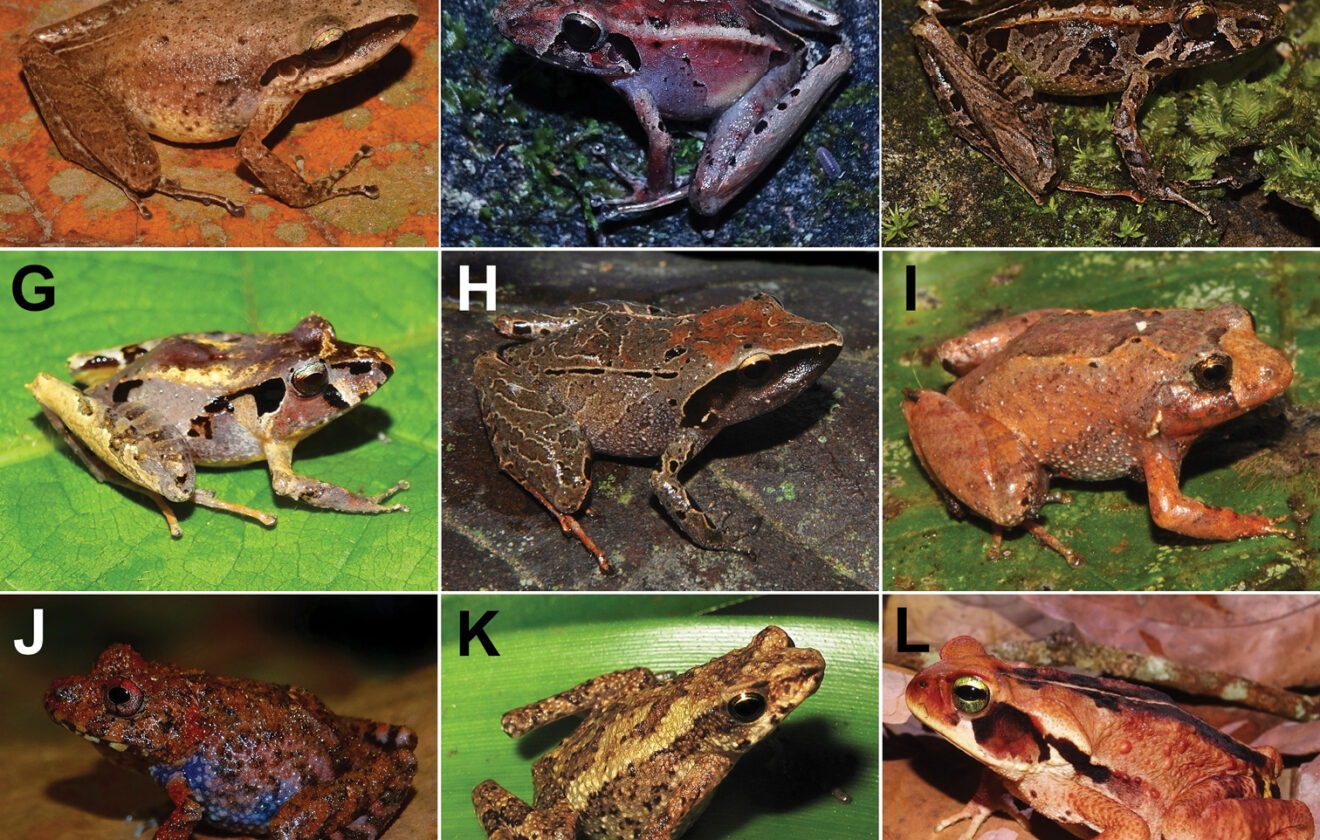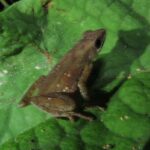Ischnocnema colibri: The Hidden Jewel of Brazil’s Atlantic Forest#
Within the lush and verdant depths of southeastern Brazil’s Atlantic rainforest hides a small wonder of the amphibian world: Ischnocnema colibri. Named evocatively after the delicate hummingbird (“colibri” in Portuguese), this tiny and elusive frog species thrills nature enthusiasts who are fortunate enough to encounter it. Belonging to a fascinating and often overlooked genus of frogs, these diminutive creatures hold vital ecological secrets, silently protecting their habitat from unseen threats.
But what makes Ischnocnema colibri particularly unique among amphibians? Imagine a frog so subtle that it can blend seamlessly into the leaf litter of one of the world’s richest ecosystems—an amphibious guardian quietly preserving the balance of life it depends upon. Join us on an immersive journey into the secret world of this captivating frog species, understanding its ecology, biology, and the ongoing efforts to preserve its delicate existence.
Taxonomy and Classification#
Ischnocnema colibri belongs to the family Brachycephalidae, a diverse family of frogs predominantly found across Central and South America. Within its family, it is classified in the genus Ischnocnema, a group known for their direct development—remarkably bypassing the tadpole stage altogether, laying eggs from which fully-formed froglets emerge.
The intriguing species name “colibri” pays homage to its hummingbird-like size and delicate presence. This frog was formally described by Brazilian herpetologists in 1998, and due to its secretive nature, remains understudied even today. Close relatives, such as Ischnocnema guentheri and Ischnocnema parva, share similar cryptic lifestyles, but colibri distinguishes itself with subtle morphological characteristics and unique vocalizations.
Natural Habitat#
The Atlantic Forest, or “Mata Atlântica,” is a biodiversity hotspot stretching across Brazil’s eastern coast—a verdant mosaic of evergreen woodland, mountainous terrain, and crystalline streams. It is here, nestled amongst damp, decaying leaves and shaded forest understory, that Ischnocnema colibri thrives. These frogs prefer humid and shaded microhabitats, rarely venturing far from cool, moist surroundings rich in mosses and leaf litter.
Geographic Range and Distribution#
Endemic to the forests of southeastern Brazil, particularly in mountainous regions of Rio de Janeiro and Espírito Santo, this cryptic frog occupies a highly specialized niche. Its distribution is comparatively narrow, indicative of its precise habitat requirements. Its presence serves as an indicator of environmental health, a bellwether for the delicate ecological balance that exists in these fragile forests.
Habitat Preferences and Adaptation#
I. colibri‘s choice of environment is not coincidental. Adaptation has sculpted its body shape, coloration, and life strategy to exploit these specific ecological niches. Its direct-developing eggs, protected by moist substrate, avoid aquatic predators that threaten more traditional tadpole development. This adaptation allows survival in the isolated terrestrial microhabitats of leaf litter and dense undergrowth.
Physical Characteristics#
Despite their small size—adults measure just 15-20 millimeters—Ischnocnema colibri possesses an intricate combination of features honed by millions of years of evolution. Their skin showcases earth-toned patterns, ranging from hues of dusty brown and pale green to blotchy grays, allowing them near-invisibility amid leaf litter. Light speckling across their backs and subtle color changes further complement their camouflage.
Adaptive Morphology#
Though tiny, these frogs exhibit muscular hind limbs and elongated digits adapted for scrambling over moist leaves and moss-covered bark. Their careful movement maintains stealth, protecting them from visual predators such as birds, snakes, and small mammals. Additionally, their unassuming appearance masks incredible physiological adaptability—humidity regulation through semi-permeable skin and fast hydration absorption—crucial for survival in their moist forest floor environment.
Behavior and Life Cycle#
The elusive nature of Ischnocnema colibri renders detailed behavioral studies challenging, yet certain captivating aspects of their behavior have been uncovered through persistent field research.
Feeding Habits#
Like many forest floor specialists, I. colibri thrives primarily on small invertebrates. Tiny insects, arachnids, and other arthropods emerging from decaying matter become their essential prey. Precision hunting tactics, combined with camouflage, grant them both stealth and surprise advantage, making them incredibly efficient predators despite their humble size.
Breeding and Vocalizations#
Perhaps the most intriguing feature in the life of I. colibri is their complex vocal communication. Their mating calls—melodic, chirping sequences reminiscent of the soft musical tones of a hummingbird’s fluttering wings—resonate gently through the twilight canopy. Males perch atop elevated substrates such as moss-covered logs or piles of leaf litter, amplifying their calls across a densely vegetated micro-landscape to attract receptive females.
Unlike typical frog species reliant on standing water to lay eggs, Ischnocnema colibri‘s direct-developing eggs eliminate aquatic risks altogether. Females carefully deposit eggs underneath leaf litter or within moist hollows, where conditions facilitate the immediate development of embryos into diminutive froglets, bypassing the vulnerable tadpole form. This unique reproductive behavior provides critical survival advantages in the terrestrial rainforest ecosystem.
Ecological Role#
Every member of a natural community plays an essential role, and Ischnocnema colibri is no exception. They serve an extraordinary function on the forest floor, regulating populations of insects and small arthropods. As prey to larger vertebrates, they bridge different trophic levels, cycling nutrients through the food web.
Furthermore, the presence and abundance of I. colibri populations offer scientists indispensable clues to environmental health. This small amphibian acts as an important biological indicator, signaling changes in habitat conditions such as humidity levels, fungal infections, or chemical contamination long before larger ecosystem-wide impacts manifest.
Threats and Conservation Status#
Despite remarkable adaptability, Ischnocnema colibri cannot escape human-induced threats. Habitat destruction due to deforestation, agriculture, illegal logging, urban expansion, and road construction diminishes fragile forest ecosystems where these creatures dwell. Climate change compounds these stressors, altering precipitation patterns, creating drier conditions unsuitable for their survival.
Currently, the International Union for Conservation of Nature (IUCN) categorizes Ischnocnema colibri as “Data Deficient.” This classification underscores the need for further research and highlights crucial gaps in knowledge, indicating scientists still lack comprehensive information on population trends and precise distribution. Conservation strategies centered around preserving and restoring Atlantic Forest habitat corridors provide meaningful avenues toward safeguarding this delicate species for future generations.
Cultural and Scientific Significance#
While small and shy, Ischnocnema colibri is imbued with significance beyond mere biological diversity. In local folklore, hummingbirds symbolize abundance, agility, and resilience; the frog’s similar qualities prompt fascination and pride among communities nestled near its habitat.
Moreover, scientists often consider amphibians biological sentinels. Ongoing studies utilizing I. colibri explore the evolution of reproductive strategies, adaptability to climate disruptions, and resilience to emerging pathogens, opening pathways to broader biological insights important for conservation and human environmental sustainability.
Conclusion#
Ischnocnema colibri quietly inspires appreciation and curiosity, hidden within the abundant biodiversity of Brazil’s Atlantic Forest. Understanding and preserving these remarkable frogs enrich our comprehension of biodiversity, ecosystems, and our own shared interconnectedness with nature. As tiny custodians of ecological health, they remind us of the fragility within our natural world and the responsibility entrusted to us.
By valuing conservation research efforts and taking active roles in supporting habitat preservation, each of us can ensure this species continues to thrive. Learn more, foster awareness, and celebrate these hidden jewels—before they quietly vanish, unnoticed, back into the leaves that conceal them.








